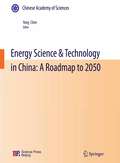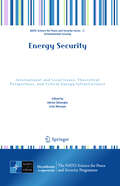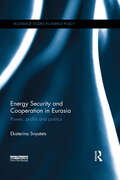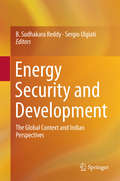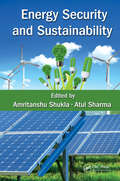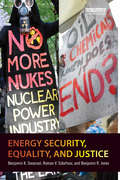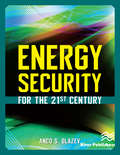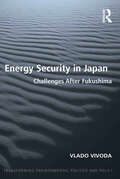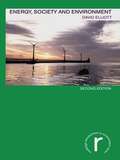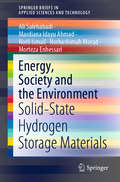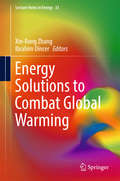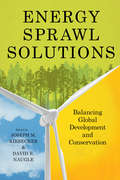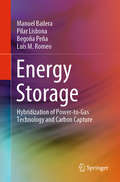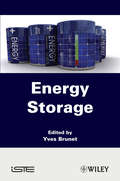- Table View
- List View
Energy Scenarios for the Future: Ways to Climate-friendly Mobility, Heating and Industry
by Cornel StanGlobal economy, principles of prosperity such as home heating and mobility are increasingly and often radically sacrificed on the altar of climate salvation in politics and media. Ignoring physics, thermodynamics, and technical diversity, monopolistic, universal solutions are decreed: automobile drives exclusively electric, reverse-running, air-sucking "household refrigerators" as heaters, electricity for the large and small, highly diverse industry solely from wind turbines and solar panels, even though their contribution has remained nearly negligible for decades. This book demystifies such dangerous climate myths based on understandable principles from physics and thermodynamics. Wind and sun are good, but by far not enough. The book describes diverse, climate-friendly fuels from plant residues, algae, used oils, and fats. It discusses "green" hydrogen as a storage or intermediate storage medium. It also describes surprising, unexpected energy scenarios that arise from the interconnection of conventional thermal machines: a jet engine combined with a steam power plant, a tank with a diesel engine as a mobile heating and power plant?
Energy Science: Principles, Technologies, and Impacts
by John Andrews Nick JelleyThe only book to successfully integrate social, economic and environmental considerations with an accessible, quantitative approach to energy science. Energy Science introduces the latest energy technologies, explaining the physical principles underlying technology and discussing their environmental, economic, and social impacts. With a focus on the transition from fossil fuels to low-carbon sources of energy, the text enables students to evaluate the key sources of energy available, and introduces potential solutions to the energy problems facing us today. A core text in the field, Energy Science is full of topical case studies and examples using current data to highlight the practical application of relevant theory. Discussion questions throughout the text encourage the development of deep critical thinking skills, ensuring that students are properly equipped to approach the energy challenges that lie ahead. Digital formats and resources The book is available for students and institutions to purchase in a variety of formats, and is supported by online resources: · The e-book offers a mobile experience and convenient access along with functionality tools, navigation features, and links that offer extra learning support: www.oxfordtextbooks.co.uk/ebooks · Online resources include multiple choice questions and further reading links for students to enhance their understanding, and, for registered adopters, a solutions manual, PowerPoint slides, figures and tables from the book · Available now: comprehensive author updates for summer 2023 include discussion of the main developments in the subject since publication
Energy Science: Principles, Technologies, and Impacts
by John Andrews Nick JelleyThe only book to successfully integrate social, economic and environmental considerations with an accessible, quantitative approach to energy science. Energy Science introduces the latest energy technologies, explaining the physical principles underlying technology and discussing their environmental, economic, and social impacts. With a focus on the transition from fossil fuels to low-carbon sources of energy, the text enables students to evaluate the key sources of energy available, and introduces potential solutions to the energy problems facing us today. A core text in the field, Energy Science is full of topical case studies and examples using current data to highlight the practical application of relevant theory. Discussion questions throughout the text encourage the development of deep critical thinking skills, ensuring that students are properly equipped to approach the energy challenges that lie ahead. Digital formats and resources The book is available for students and institutions to purchase in a variety of formats, and is supported by online resources: · The e-book offers a mobile experience and convenient access along with functionality tools, navigation features, and links that offer extra learning support: www.oxfordtextbooks.co.uk/ebooks · Online resources include multiple choice questions and further reading links for students to enhance their understanding, and, for registered adopters, a solutions manual, PowerPoint slides, figures and tables from the book · Available now: comprehensive author updates for summer 2023 include discussion of the main developments in the subject since publication
Energy Science and Applied Technology: Proceedings of the 2nd International Conference on Energy Science and Applied Technology (ESAT 2015)
by Zhigang FangEnergy Science and Applied Technology includes contributions on a wide range of topics:- Technologies in geology, mining, oil and gas exploration and exploitation of deposits- Energy transfer and conversion, materials and chemical technologies- Environmental engineering and sustainable development- Electrical and electronic technology, power system
Energy Science and Applied Technology ESAT 2016: Proceedings of the International Conference on Energy Science and Applied Technology (ESAT 2016), Wuhan, China, June 25-26, 2016
by Zhigang FangThe 2016 International Conference on Energy Science and Applied Technology (ESAT 2016) held on June 25-26 in Wuhan, China aimed to provide a platform for researchers, engineers, and academicians, as well as industrial professionals, to present their research results and development activities in energy science and engineering and its applied technology. The themes presented in Energy Science and Applied Technology ESAT 2016 are: Technologies in Geology, Mining, Oil and Gas;Renewable Energy, Bio-Energy and Cell Technologies;Energy Transfer and Conversion, Materials and Chemical Technologies;Environmental Engineering and Sustainable Development;Electrical and Electronic Technology, Power System Engineering;Mechanical, Manufacturing, Process Engineering;Control and Automation;Communications and Applied Information Technologies;Applied and Computational Mathematics;Methods and Algorithms Optimization;Network Technology and Application;System Test, Diagnosis, Detection and Monitoring;Recognition, Video and Image Processing.
Energy Science & Technology in China: A Roadmap to 2050
by Yong ChenAs one of the eighteen field-specific reports comprising the comprehensive scope of the strategic general report of the Chinese Academy of Sciences, this sub-report addresses long-range planning for developing science and technology in the field of energy science. They each craft a roadmap for their sphere of development to 2050. In their entirety, the general and sub-group reports analyze the evolution and laws governing the development of science and technology, describe the decisive impact of science and technology on the modernization process, predict that the world is on the eve of an impending S&T revolution, and call for China to be fully prepared for this new round of S&T advancement. Based on the detailed study of the demands on S&T innovation in China's modernization, the reports draw a framework for eight basic and strategic systems of socio-economic development with the support of science and technology, work out China's S&T roadmaps for the relevant eight basic and strategic systems in line with China's reality, further detail S&T initiatives of strategic importance to China's modernization, and provide S&T decision-makers with comprehensive consultations for the development of S&T innovation consistent with China's reality. Supported by illustrations and tables of data, the reports provide researchers, government officials and entrepreneurs with guidance concerning research directions, the planning process, and investment. Founded in 1949, the Chinese Academy of Sciences is the nation's highest academic institution in natural sciences. Its major responsibilities are to conduct research in basic and technological sciences, to undertake nationwide integrated surveys on natural resources and ecological environment, to provide the country with scientific data and consultations for government's decision-making, to undertake government-assigned projects with regard to key S&T problems in the process of socio-economic development, to initiate personnel training, and to promote China's high-tech enterprises through its active engagement in these areas.
Energy Security: International and Local Issues, Theoretical Perspectives, and Critical Energy Infrastructures (NATO Science for Peace and Security Series C: Environmental Security)
by Adrian V. Gheorghe Liviu MuresanIn terms of energy security the Black Sea region is important to Europe. Inevitably and for very good reasons, a lot of attention has been given to the existing and planned pipeline routes going around or across the Black Sea. Much less attention has been given to the development of the Black Sea energy market in its own right and to the potential advantages of coping with some current and future energy issues in a multilateral regional format rather than through individual action at national level. The present book addresses, in a comprehensive manner, the current problematic of energy security and goes beyond pipeline politics, without playing down their continued significance; it addresses some topical questions related to the sustainability and resilience of energy systems as applicable to the Black Sea region.
Energy Security and Cooperation in Eurasia: Power, profits and politics (Routledge Studies in Energy Policy)
by Ekaterina SvyatetsWhy are bilateral relations, especially in the area of energy security, so different in the cases of U.S.-Russia, U.S.-Azerbaijan, and Russia-Germany energy deals? Why do some states find common ground despite differences, while others, with all the seemingly favourable conditions, are sinking into animosity? Energy Security and Cooperation in Eurasia explores varying outcomes of energy cooperation, defined as diplomatic relations, bilateral trade, and investment in oil and natural gas. The book looks at economic potential, geopolitical rivalry, and domestic interest groups in the cases of U.S.-Russia, U.S.-Azerbaijan, and Russia-Germany energy ties. It looks at major projects in each case (Sakhalin and Arctic oil and gas production, Baku-Tbilisi-Ceyhan and Nord Stream pipelines) and activities of international oil companies. The book also provides a detailed analysis of the situation in Ukraine since 2014 and Russia’s annexation of Crimea, and their effect on European energy security. This book utilizes an innovative approach of exploring the dyads of states (bilateral relations) along the economic, geopolitical, and domestic lobbying dimensions. This book is a valuable resource for graduate and undergraduate students, academics and researchers in the areas of Security, Political Economy, Comparative Politics, post-Soviet studies, as well as for general public.
Energy Security and Cooperation in Eurasia: Power, profits and politics (Routledge Studies in Energy Policy)
by Ekaterina SvyatetsWhy are bilateral relations, especially in the area of energy security, so different in the cases of U.S.-Russia, U.S.-Azerbaijan, and Russia-Germany energy deals? Why do some states find common ground despite differences, while others, with all the seemingly favourable conditions, are sinking into animosity? Energy Security and Cooperation in Eurasia explores varying outcomes of energy cooperation, defined as diplomatic relations, bilateral trade, and investment in oil and natural gas. The book looks at economic potential, geopolitical rivalry, and domestic interest groups in the cases of U.S.-Russia, U.S.-Azerbaijan, and Russia-Germany energy ties. It looks at major projects in each case (Sakhalin and Arctic oil and gas production, Baku-Tbilisi-Ceyhan and Nord Stream pipelines) and activities of international oil companies. The book also provides a detailed analysis of the situation in Ukraine since 2014 and Russia’s annexation of Crimea, and their effect on European energy security. This book utilizes an innovative approach of exploring the dyads of states (bilateral relations) along the economic, geopolitical, and domestic lobbying dimensions. This book is a valuable resource for graduate and undergraduate students, academics and researchers in the areas of Security, Political Economy, Comparative Politics, post-Soviet studies, as well as for general public.
Energy Security and Development: The Global Context and Indian Perspectives
by B. Sudhakara Reddy Sergio UlgiatiThis volume provides a systematic framework for energy suppliers, policy makers, academics, students, and all others interested in energy security, and analyzes key issues concerning energy, security and sustainability with the help of a wealth of data. While sustainability is the broadest objective, energy security is an important part of it, at the global, national and societal levels. The development of a sustainable, long-term solution to meeting the world’s energy needs is a defining issue of our time, since central global challenges that the world faces—poverty alleviation, climate change, and environmental degradation—are directly linked to energy security. The contributions cover key issues in sustainable energy and illustrate that the insecurity of a majority of countries owes to internal factors which have more to do with market forces, inefficient technologies, lack of institutions, environmental insecurity, pricing mechanisms, etc., and less to do with the international situation.The links between energy and development are both direct and indirect. Directly, energy provides several services and utilities to maintain human well-being, and also does so indirectly through stakeholders. This volume addresses both the direct and indirect links and provides sustainable alternatives, helping readers to better grasp the resilience of both socio-economic and resource sub-systems in the process. The issues affecting energy supply and demand, including technology portfolios, environmental considerations and consumer attitudes are thoroughly discussed. One of the critical questions that arises is how to facilitate energy investment. The investment climate and the key issues involved are analyzed, including: the capital flows with reasonable and stable investment frameworks, timely decision-making by governments, and open markets. The broad objective of the volume is to foster a deeper understanding of the concept of energy security and to identify the methods of analysis, policy initiatives and future research needed to generate a balanced pattern of energy use and mitigate its impact on humanity and the environment.
Energy Security and Sustainability
by Amritanshu Shukla Atul SharmaThere has been ever increasing interest in understanding the various aspects of available resources and production, in terms of need and supply, conservation and environmental impacts and so on. From the current energy scenario, it is very clear that there are serious challenges related in achieving energy sustainability and security worldwide. The aim of this book is to present an overview of progress made towards energy sustainability addressing concerns regarding carbon emission and clean energy resources. Keeping this in mind, the book has chapters on all major energy sources which are being utilized at present, along with those having potential prospects for future.
Energy Security, Equality and Justice
by Benjamin K. Sovacool Roman V. Sidortsov Benjamin R. JonesThis book applies concepts from ethics, justice, and political philosophy to five sets of contemporary energy problems cutting across time, economics, politics, geography, and technology. In doing so, the authors derive two key energy justice principles from modern theories of distributive justice, procedural justice, and cosmopolitan justice. The prohibitive principle states that "energy systems must be designed and constructed in such a way that they do not unduly interfere with the ability of people to acquire those basic goods to which they are justly entitled." The affirmative principle states that "if any of the basic goods to which people are justly entitled can only be secured by means of energy services, then in that case there is also a derivative entitlement to the energy services." In laying out and employing these principles, the book details a long list of current energy injustices ranging from human rights abuses and energy-related civil conflict to energy poverty and pervasive and growing negative externalities. The book illustrates the significance of energy justice by combining the most up-to-date data on global energy security and climate change, including case studies and examples from the electricity supply, transport, and heating and cooking sectors, with appraisals based on centuries of thought about the meaning of justice in social decisions.
Energy Security, Equality and Justice
by Benjamin K. Sovacool Roman V. Sidortsov Benjamin R. JonesThis book applies concepts from ethics, justice, and political philosophy to five sets of contemporary energy problems cutting across time, economics, politics, geography, and technology. In doing so, the authors derive two key energy justice principles from modern theories of distributive justice, procedural justice, and cosmopolitan justice. The prohibitive principle states that "energy systems must be designed and constructed in such a way that they do not unduly interfere with the ability of people to acquire those basic goods to which they are justly entitled." The affirmative principle states that "if any of the basic goods to which people are justly entitled can only be secured by means of energy services, then in that case there is also a derivative entitlement to the energy services." In laying out and employing these principles, the book details a long list of current energy injustices ranging from human rights abuses and energy-related civil conflict to energy poverty and pervasive and growing negative externalities. The book illustrates the significance of energy justice by combining the most up-to-date data on global energy security and climate change, including case studies and examples from the electricity supply, transport, and heating and cooking sectors, with appraisals based on centuries of thought about the meaning of justice in social decisions.
Energy Security for the 21st Century
by Anco S. BlazevThis book takes a very close look at energy and energy security from a hands-on, technical point of view with an ultimate goal of sorting out and explaining the deep meaning of energy as well as the key factors and variables of our energy security. The book reviews the major energy sources—coal, crude oil, natural gas, the renewables, and other alternative fuels and technologies—according to the way they affect our energy security now and what consequences might be expected in the future. Topics include the different technical, logistics, regulatory, social, political, and financial aspects of modern energy products and technologies. The advantages and disadvantages of the different fuels, technologies, energy strategies, regulations, and policies are reviewed in detail, sorted, and clearly laid out as well as their effects on our present and future energy security in a way that is easy to understand by high school students, engineers, and professors alike. This book is a must-read for energy executives, environmental specialists, investors, bankers, lawyers, regulators, politicians, and anyone involved, or interested, in today’s energy production and use and their effects on our energy security.
Energy Security in Japan: Challenges After Fukushima (Transforming Environmental Politics and Policy)
by Vlado VivodaFor a country already uneasy about energy security, the 2011 earthquake and tsunami, which caused a nuclear catastrophe at the Fukushima nuclear power plant, turned pre-existing Japanese concern about the availability of energy into outright anxiety. The subsequent closure of many nuclear reactors meant Japan needed to replace lost power quickly and so had no choice but to secure additional fossil fuels, undermining Japanese diversification policy and increasing global and regional competition for energy. This switch has been at a cost to the already weak Japanese economy whilst the increase in fossil fuel consumption has caused a significant increase in greenhouse gas emissions. In this book Vlado Vivoda examines the drastically changed environment following the disaster in order to analyse Japan’s energy security challenges and evaluate Tokyo’s energy policy options. Looking at how the disaster exacerbated Japan’s existing energy security challenges, Vivoda considers the best policy options for Japan to enhance national energy security in the future, exploring the main impediments to change and how they might be overcome.
Energy Security in Japan: Challenges After Fukushima (Transforming Environmental Politics and Policy)
by Vlado VivodaFor a country already uneasy about energy security, the 2011 earthquake and tsunami, which caused a nuclear catastrophe at the Fukushima nuclear power plant, turned pre-existing Japanese concern about the availability of energy into outright anxiety. The subsequent closure of many nuclear reactors meant Japan needed to replace lost power quickly and so had no choice but to secure additional fossil fuels, undermining Japanese diversification policy and increasing global and regional competition for energy. This switch has been at a cost to the already weak Japanese economy whilst the increase in fossil fuel consumption has caused a significant increase in greenhouse gas emissions. In this book Vlado Vivoda examines the drastically changed environment following the disaster in order to analyse Japan’s energy security challenges and evaluate Tokyo’s energy policy options. Looking at how the disaster exacerbated Japan’s existing energy security challenges, Vivoda considers the best policy options for Japan to enhance national energy security in the future, exploring the main impediments to change and how they might be overcome.
Energy Smart Appliances: Applications, Methodologies, and Challenges
by Antonio Moreno-Munoz Neomar GiacominiEnergy Smart Appliances Enables designers and manufacturers to manage real-world energy performance and expectations by covering a range of potential scenarios and challenges Energy Smart Appliances provides utilities and appliance manufacturers, and designers with new approaches to better understand real-world performance, assess actual energy benefits, and tailor each technology to the needs of their customers. With contributions from a fully international group of experts, including heads of prestigious research organizations and leading universities, and innovation managers of the main appliance manufacturers, Energy Smart Appliances includes discussion on: Enabling technologies for energy smart appliances, covering IoT devices and technology and active energy efficiency measures in residential environments Smart home and appliances, answering questions like ‘Where are we heading in terms of the overall smart homes’ future?’ and ‘What’s the energy impact from smart home devices?’ Demand-side management and demand response, covering overall system/ appliances readiness and ideal energy management scenario to drive demand response Energy smart appliances’ best practices and success stories, including refrigerators, washers, dryers, and more With practical coverage of a wide range of potential scenarios and existing and future challenges, Energy Smart Appliances is an essential learning resource for electrical engineering professionals, equipment manufacturers, and designers, along with postgraduate electrical engineering students and researchers in related fields and programs of study.
Energy Smart Appliances: Applications, Methodologies, and Challenges
by Antonio Moreno-Munoz Neomar GiacominiEnergy Smart Appliances Enables designers and manufacturers to manage real-world energy performance and expectations by covering a range of potential scenarios and challenges Energy Smart Appliances provides utilities and appliance manufacturers, and designers with new approaches to better understand real-world performance, assess actual energy benefits, and tailor each technology to the needs of their customers. With contributions from a fully international group of experts, including heads of prestigious research organizations and leading universities, and innovation managers of the main appliance manufacturers, Energy Smart Appliances includes discussion on: Enabling technologies for energy smart appliances, covering IoT devices and technology and active energy efficiency measures in residential environments Smart home and appliances, answering questions like ‘Where are we heading in terms of the overall smart homes’ future?’ and ‘What’s the energy impact from smart home devices?’ Demand-side management and demand response, covering overall system/ appliances readiness and ideal energy management scenario to drive demand response Energy smart appliances’ best practices and success stories, including refrigerators, washers, dryers, and more With practical coverage of a wide range of potential scenarios and existing and future challenges, Energy Smart Appliances is an essential learning resource for electrical engineering professionals, equipment manufacturers, and designers, along with postgraduate electrical engineering students and researchers in related fields and programs of study.
Energy, Society and Environment (Routledge Introductions to Environment: Environment and Society Texts)
by David ElliottSociety's use of energy and technology is at heart of many of the most significant environmental problems of recent years, including problems of health, global warming and acid rain. Use of technology has been a major cause of environmental problems but new technology offers many solutions.Energy, Society and Environment is an introduction to energy and energy use, and the interactions between technology, society and the environment. The book is clearly structured to examine:* key environmental issues, and the harmful impacts of energy use* new technological solutions to environmental problems* implementation of possible solutions* implications for society in developing a sustainable approach to energy use.Social processes and strategic solutions to problems are located within a clear, technological context with topical case studies and informative diagrams illustrating key issues.Energy, Society and Environment examines the potential and limits of technical solutions to environmental problems and suggests the social, economic and political changes necessary to avoid serious environmental damage in the future.
Energy, Society and Environment (Routledge Introductions to Environment: Environment and Society Texts)
by David ElliottSociety's use of energy and technology is at heart of many of the most significant environmental problems of recent years, including problems of health, global warming and acid rain. Use of technology has been a major cause of environmental problems but new technology offers many solutions.Energy, Society and Environment is an introduction to energy and energy use, and the interactions between technology, society and the environment. The book is clearly structured to examine:* key environmental issues, and the harmful impacts of energy use* new technological solutions to environmental problems* implementation of possible solutions* implications for society in developing a sustainable approach to energy use.Social processes and strategic solutions to problems are located within a clear, technological context with topical case studies and informative diagrams illustrating key issues.Energy, Society and Environment examines the potential and limits of technical solutions to environmental problems and suggests the social, economic and political changes necessary to avoid serious environmental damage in the future.
Energy, Society and the Environment: Solid-State Hydrogen Storage Materials (SpringerBriefs in Applied Sciences and Technology)
by Ali Salehabadi Mardiana Idayu Ahmad Norli Ismail Norhashimah Morad Morteza EnhessariThis book provides a comprehensive and contemporary overview of advances in energy and energy storage technologies. Although the coverage is varied and diverse, the book also addresses unifying patterns and trends in order to enrich readers’ understanding of energy and energy storage systems, particularly hydrogen energy storage, including e.g. their morphology, porosity and material structure. Readers will also gain insights into the hydrogen storage performance landscape, based on data released by the US Department of Energy (DOE), providing a basis for understanding real-world applications. The book also discusses the superior hydrogen storage performance of solid-state materials and explores the physical and chemical properties that can potentially affect their performance.
Energy Solutions to Combat Global Warming (Lecture Notes in Energy #33)
by XinRong Zhang Ibrahim DincerThis book gathers an in-depth collection of 45 selected papers presented at the Global Conference on Global Warming 2014 in Beijing, China, covering a broad variety of topics from the main principles of thermodynamics and their role in design, analysis, and the improvements in performance of energy systems to the potential impact of global warming on human health and wellbeing. Given energy production’s role in contributing to global warming and climate change, this work provides solutions to global warming from the point of view of energy. Incorporating multi-disciplinary expertise and approaches, it provides a platform for the analysis of new developments in the area of global warming and climate change, as well as potential energy solutions including renewable energy, energy efficiency, energy storage, hydrogen production, CO2 capture and environmental impact assessment. The research and analysis presented herein will benefit international scientists, researchers, engineers, policymakers and all others with an interest in global warming and its potential solutions.
Energy Sprawl Solutions: Balancing Global Development and Conservation
by Joseph M. Kiesecker and David E. NaugleThe editors provide a roadmap for preserving biodiversity despite the threats of energy sprawl. Their strategy—development by design—brings together companies, communities, and governments to craft blueprints for sustainable land development. This commonsense approach identifies and preemptively sets aside land where biodiversity can thrive while consolidating development in areas with lower biodiversity value. This approach makes sense for energy industries and governments, which can confidently build sustainability into their energy futures.
Energy Storage: Hybridization of Power-to-Gas Technology and Carbon Capture (Springerbriefs In Energy Ser.)
by Manuel Bailera Pilar Lisbona Begoña Peña Luis M. RomeoThis book presents a detailed analysis of Power-to-Gas, a promising energy storage technology. It discusses the main mechanisms involved, and presents two Power-to-Gas and carbon capture hybridizations. The book begins by providing an introduction to energy storage technologies. It then reviews a number of Power-to-Gas projects now in progress, highlighting the current barriers to commercializing the technology. Moreover, the book presents two novel Power-to-Gas hybridizations, which improve the technology’s applicability in terms of efficiency, utilization of resources and profitability. Given its scope, the book will be of interest to graduate students, researchers and practitioners in the fields of engineering and energy.
Energy Storage
by Yves BrunetEnergy storage examines different applications such as electric power generation, transmission and distribution systems, pulsed systems, transportation, buildings and mobile applications. For each of these applications, proper energy storage technologies are foreseen, with their advantages, disadvantages and limits. As electricity cannot be stored cheaply in large quantities, energy has to be stored in another form (chemical, thermal, electromagnetic, mechanical) and then converted back into electric power and/or energy using conversion systems. Most of the storage technologies are examined: batteries, hydrogen, super capacitors, SMES, flywheels, CAES, thermal storage and hydraulic gravitational storage.




